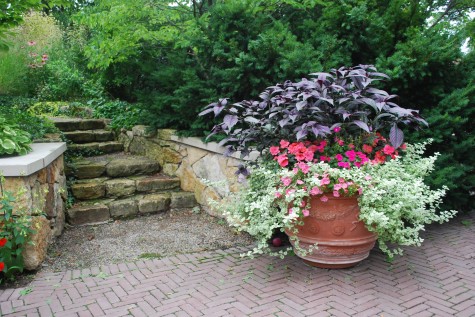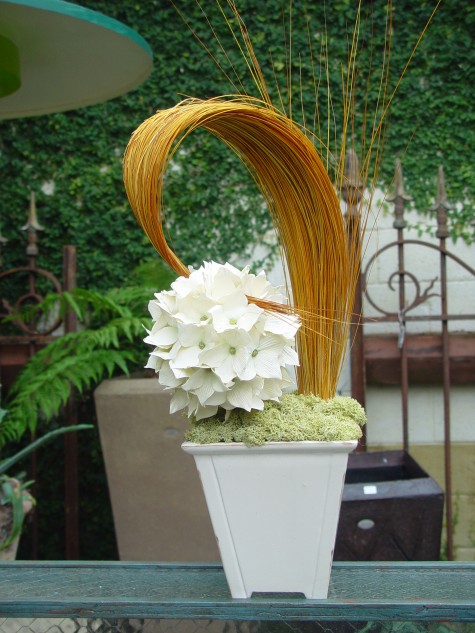 The last two nights the temperatures have been in the high forties and low fifties. Great. I am on the deck last night- in my fleece-having a glass of wine, and contemplating the end of summer. My plants in my pots have gone from gorgeous to grumpy. What to do? The topiary sculptures I make from natural materials in the fall and winter help me face the 6 months we have coming up in Michigan when the garden is dormant. The sculptures are set in dry florist’s foam-I use the John Henry brand. This sculpture, made from a dyed and preserved grass, preserved reindeer moss, and paper dogwood flowers, helps me to bring the beauty of the garden indoors.
The last two nights the temperatures have been in the high forties and low fifties. Great. I am on the deck last night- in my fleece-having a glass of wine, and contemplating the end of summer. My plants in my pots have gone from gorgeous to grumpy. What to do? The topiary sculptures I make from natural materials in the fall and winter help me face the 6 months we have coming up in Michigan when the garden is dormant. The sculptures are set in dry florist’s foam-I use the John Henry brand. This sculpture, made from a dyed and preserved grass, preserved reindeer moss, and paper dogwood flowers, helps me to bring the beauty of the garden indoors.
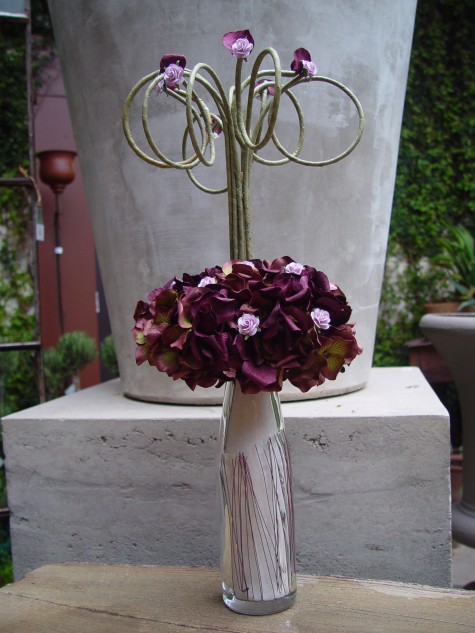 Glass can make great containers for sculptures. This vase by the Parisian artist Vanessa Mittrani is filled with white sand to give it weight. I seal the sand in the vase with a giant blob of hot melt glue, and wedge the foam in the top. Paper hydrangeas, mini-roses, and paper covered wire make for a sassy little something that reminds me of the garden. The purple paper hydrangeas bring out the purple/rust color of the wire in the glass.
Glass can make great containers for sculptures. This vase by the Parisian artist Vanessa Mittrani is filled with white sand to give it weight. I seal the sand in the vase with a giant blob of hot melt glue, and wedge the foam in the top. Paper hydrangeas, mini-roses, and paper covered wire make for a sassy little something that reminds me of the garden. The purple paper hydrangeas bring out the purple/rust color of the wire in the glass.
 I consider paper a natural material, since it comes from trees. This combination of paper hydrangea petals, and diminuitive paper daisies describe a classic topiary cone shape. The flowery pompom at the top is constructed from individual dried bleached seed pods.
I consider paper a natural material, since it comes from trees. This combination of paper hydrangea petals, and diminuitive paper daisies describe a classic topiary cone shape. The flowery pompom at the top is constructed from individual dried bleached seed pods.
 Integrifolia is a plant native to Australia, and probably other places as well. The leaves hold tight to the stems for a long time; they also take dye beautifully. This topiary began with individual leaves glued to a spherical form in a pattern reminiscent of an artichoke. As I worked towards the bottom, I reversed the curve on the individual leaves for more volume. The very bottom of the sphere is stuck with short branches just a few inches in length. Preserved reeds bowing out from a twig trunck make for a stem; the base is covered in preserved green seedheads.
Integrifolia is a plant native to Australia, and probably other places as well. The leaves hold tight to the stems for a long time; they also take dye beautifully. This topiary began with individual leaves glued to a spherical form in a pattern reminiscent of an artichoke. As I worked towards the bottom, I reversed the curve on the individual leaves for more volume. The very bottom of the sphere is stuck with short branches just a few inches in length. Preserved reeds bowing out from a twig trunck make for a stem; the base is covered in preserved green seedheads.
 Paper roses on paper covered wires are a delicate contrast to the heft of dried okra pods.
Paper roses on paper covered wires are a delicate contrast to the heft of dried okra pods.
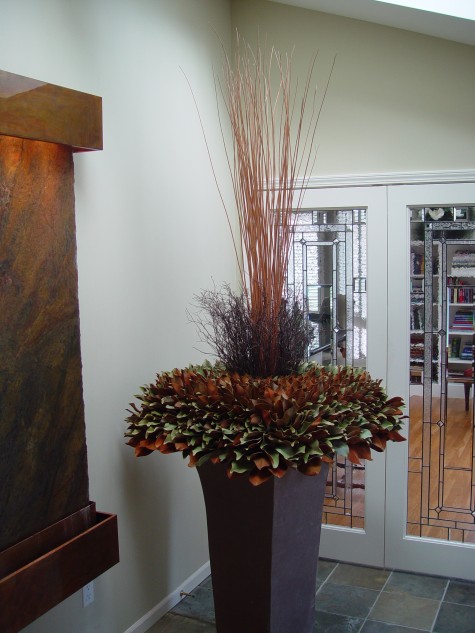 This very large scale sculpture has twigs and short birch branches for a centerpiece; the collar was constructed of fresh southern magnolia leaves. Magnolia dries beautifully, and lasts a long time.
This very large scale sculpture has twigs and short birch branches for a centerpiece; the collar was constructed of fresh southern magnolia leaves. Magnolia dries beautifully, and lasts a long time.
 The science of preserving natural materials has become quite sophisticated. I for one would never have a house plant. I am happy for the season where I am not a plant caretaker. An object like this demands nothing from me; I just look. The reindeer moss in a color they call spring green is my idea of good color.
The science of preserving natural materials has become quite sophisticated. I for one would never have a house plant. I am happy for the season where I am not a plant caretaker. An object like this demands nothing from me; I just look. The reindeer moss in a color they call spring green is my idea of good color.
 These steel leaves are by no means a natural material, but they describe one. The base was buttered with ceramic tile mastic, and embedded with tiny shells. The stainless steel wire is difficult to handle; I usually have to get help from a second pair of hands to glue it in.
These steel leaves are by no means a natural material, but they describe one. The base was buttered with ceramic tile mastic, and embedded with tiny shells. The stainless steel wire is difficult to handle; I usually have to get help from a second pair of hands to glue it in.
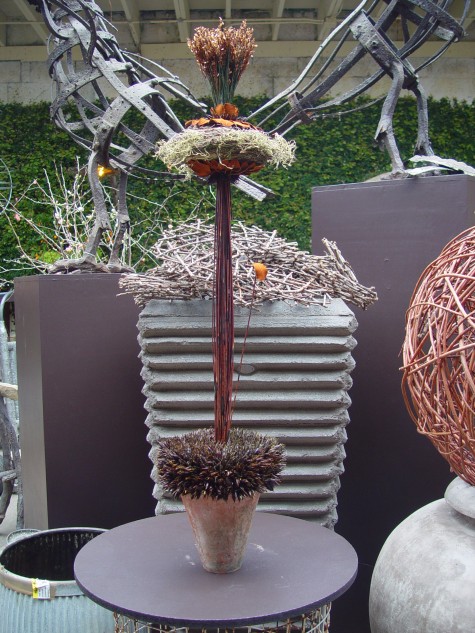 This whimsical topairy makes use of two bird’s nests made of various natural materials, sandwiched together. I buy these long stems covered with hundreds of chocolate seeds. After taking the seeds from the stem, I glued the individual seeds onto this base.
This whimsical topairy makes use of two bird’s nests made of various natural materials, sandwiched together. I buy these long stems covered with hundreds of chocolate seeds. After taking the seeds from the stem, I glued the individual seeds onto this base.
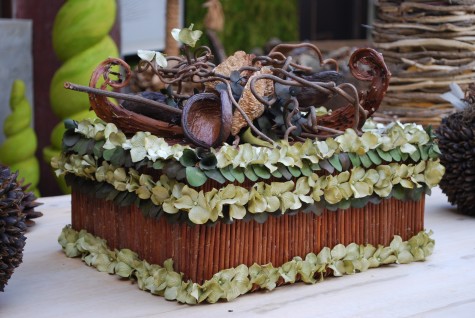 I call this a presentation box. The box itself is a photo box meant to hold 8 x 10 photographs. Should the box never have anything in it, it will still be fun to look at.
I call this a presentation box. The box itself is a photo box meant to hold 8 x 10 photographs. Should the box never have anything in it, it will still be fun to look at.

My landscape superintendent gave me a book on crop circles. I am embarassed to say I had never heard of them. This sculpture I made was motivated by my excitement about those circles. I stuffed the pocket created by gluing two magnolia leaves together with all manner of dried snippets from the garden. I scratched my own version of a crop circle into the magnolia leaf around a hole in the leaf. Today I will cut some limelight hydrangeas pinking in the cool weather to dry. Okay, its September in Michigan.
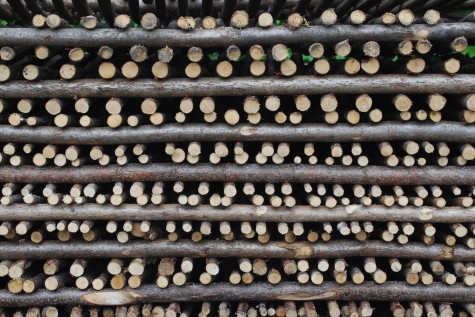 I wrote a few days ago regarding my excitement about the delivery of a container load of hazel wood hurdles from Belgium; the order we placed in May finally arrived. Wattles and hurdles are panels, woven from the coppice wood of willow and hazel wood. I personally favor the heft and longevity of the hazel wood; it is vastly more durable and substantial than willow. Coppicing is the practice of cutting trees or shrubs to the quick, with the intent of harvesting the branches for fuel, or fencing. The shrub or tree regrows, only to have its branches harvested again. Woven hurdles keep the livestock out of the vegetable garden. They border herb and vegetable gardens. They provide privacy without being utterly opaque. They work wherever they are needed. Woven hurdles are a fence material friendly to a garden or landscape of any point of view.
I wrote a few days ago regarding my excitement about the delivery of a container load of hazel wood hurdles from Belgium; the order we placed in May finally arrived. Wattles and hurdles are panels, woven from the coppice wood of willow and hazel wood. I personally favor the heft and longevity of the hazel wood; it is vastly more durable and substantial than willow. Coppicing is the practice of cutting trees or shrubs to the quick, with the intent of harvesting the branches for fuel, or fencing. The shrub or tree regrows, only to have its branches harvested again. Woven hurdles keep the livestock out of the vegetable garden. They border herb and vegetable gardens. They provide privacy without being utterly opaque. They work wherever they are needed. Woven hurdles are a fence material friendly to a garden or landscape of any point of view. I have a client who has become a friend; he supports Michigan industry in a big way and was so pleased these stripped cedar fence poles we bought are Michigan grown. Though I ordered 5″ diameter poles, 10 feet long, they looked like telephone poles when they got delivered from a supplier in Michigan’s Upper Peninsula. As I relentlessly speak to issues of proportion, I was worried I had gone over the edge by an inch. I was wringing my hands, until the fence went up. I should not have worried. The size of the pole was perfect for the heft and texture of the fence. The bare cedar poles are a good contrast to the woven hazel wood, which has all of its bark intact.
I have a client who has become a friend; he supports Michigan industry in a big way and was so pleased these stripped cedar fence poles we bought are Michigan grown. Though I ordered 5″ diameter poles, 10 feet long, they looked like telephone poles when they got delivered from a supplier in Michigan’s Upper Peninsula. As I relentlessly speak to issues of proportion, I was worried I had gone over the edge by an inch. I was wringing my hands, until the fence went up. I should not have worried. The size of the pole was perfect for the heft and texture of the fence. The bare cedar poles are a good contrast to the woven hazel wood, which has all of its bark intact.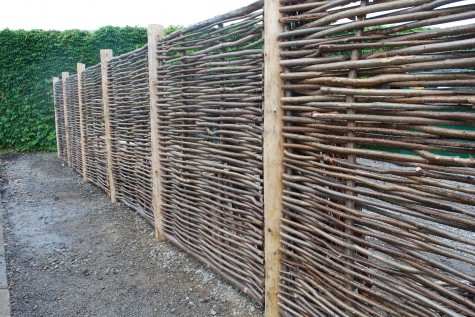 There is no substitute for the time when the talk ends, and the making begins. We set a pole down 24″ or so below grade, and set a panel up next to it. These panels are made by hand, and vary in width somewhat. One pole, one panel, and so on. This one step at a time construction ensures that the space between two poles is fitted to a specific panel. Steve toe-nail screwed the panels to the center of each post; this is a sturdy construction. What I like even better? This fence has no back or front; the panels are the same back and front. How friendly is this to neighboring properties? This fence looks good to both sides.
There is no substitute for the time when the talk ends, and the making begins. We set a pole down 24″ or so below grade, and set a panel up next to it. These panels are made by hand, and vary in width somewhat. One pole, one panel, and so on. This one step at a time construction ensures that the space between two poles is fitted to a specific panel. Steve toe-nail screwed the panels to the center of each post; this is a sturdy construction. What I like even better? This fence has no back or front; the panels are the same back and front. How friendly is this to neighboring properties? This fence looks good to both sides.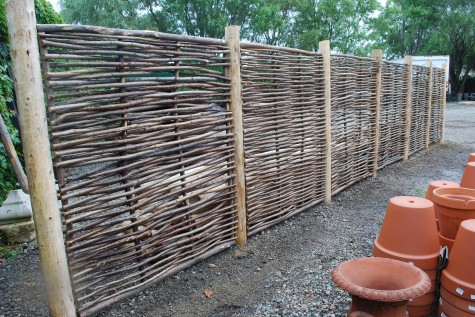 I have a client who plans to screen his hot tub with this fencing. It was the subject of intense debate today-will these hurdles screen a man who is happily skinny dipping? I vote yes-unless the neighbor plans to be close enough to see through the hurdle branches. The neighbor with his nose pressed to the fence-that is the subject of another essay, is it not? The fence is also friendly to vines that need to grip to climb. Clematis grown on this fence is especially lovely. We are careful to install the fence slightly above the existing grade of the ground. Wood in constant contact with soil will deteriorate much more quickly than wood that is able to shed water.
I have a client who plans to screen his hot tub with this fencing. It was the subject of intense debate today-will these hurdles screen a man who is happily skinny dipping? I vote yes-unless the neighbor plans to be close enough to see through the hurdle branches. The neighbor with his nose pressed to the fence-that is the subject of another essay, is it not? The fence is also friendly to vines that need to grip to climb. Clematis grown on this fence is especially lovely. We are careful to install the fence slightly above the existing grade of the ground. Wood in constant contact with soil will deteriorate much more quickly than wood that is able to shed water.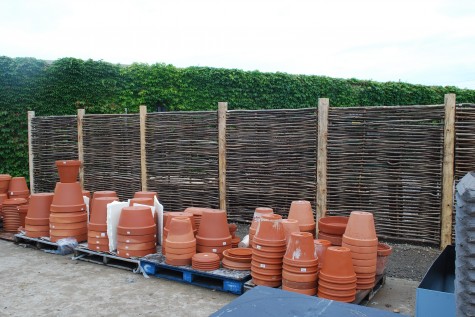 The fence is good looking with contemporary steel ornament, traditional terra cotta pots, a funky birdbath made from recycled materials, or a formal lead cistern fountain. This is by way of saying this fence looks good with almost anything. As to its longevity, imagine how long it takes a dead tree to fall and deteriorate. Branches and twigs are not good materials for the compost pile, as they break down so slowly. We have stocked this fencing for 8 years now. I have yet to have someone tell me it had disintegrated. Wood fences do age though-that is part of their charm.
The fence is good looking with contemporary steel ornament, traditional terra cotta pots, a funky birdbath made from recycled materials, or a formal lead cistern fountain. This is by way of saying this fence looks good with almost anything. As to its longevity, imagine how long it takes a dead tree to fall and deteriorate. Branches and twigs are not good materials for the compost pile, as they break down so slowly. We have stocked this fencing for 8 years now. I have yet to have someone tell me it had disintegrated. Wood fences do age though-that is part of their charm.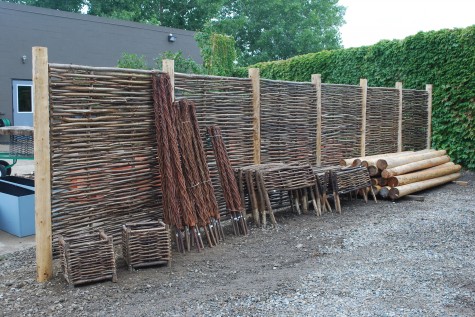
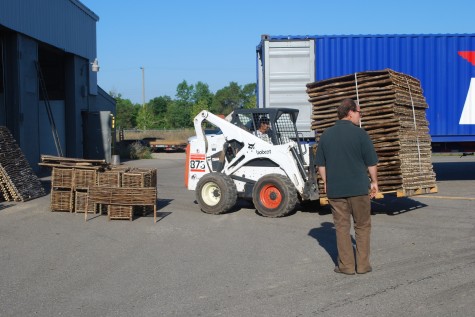 Wattle, or hurdle fencing is a traditional garden or livestock enclosure made from either willow or hazelwood. Last week we took delivery of a forty foot long container of Belgian made fencing. Though I am making a point of shopping my own country, I am especially attracted to Belgian garden ornament. Rob says the Belgian climate and topography is a lot like the Midwest. My most favorite landscape photographer Lynn Geesamon has photographed all over the world. Her images of Belgium so strongly resonate with me, as I do think they remind me of my native landscape. Some of her images can be seen at
Wattle, or hurdle fencing is a traditional garden or livestock enclosure made from either willow or hazelwood. Last week we took delivery of a forty foot long container of Belgian made fencing. Though I am making a point of shopping my own country, I am especially attracted to Belgian garden ornament. Rob says the Belgian climate and topography is a lot like the Midwest. My most favorite landscape photographer Lynn Geesamon has photographed all over the world. Her images of Belgium so strongly resonate with me, as I do think they remind me of my native landscape. Some of her images can be seen at 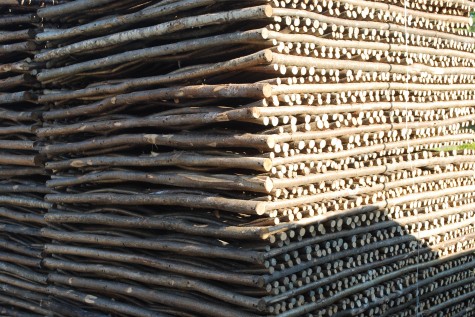 A garden ornament does need to look like it belongs to the garden in which it is placed. It takes some doing to bring these twig structures from their place to mine, but it is worth it. They are heavy, chunky and sturdy-and beautifully constructed. Each five by six foot panel weighs 100 pounds-substantial. We buy peeled cedar fence poles from a company in the upper peninsula of Michigan. This material has a very local feel.
A garden ornament does need to look like it belongs to the garden in which it is placed. It takes some doing to bring these twig structures from their place to mine, but it is worth it. They are heavy, chunky and sturdy-and beautifully constructed. Each five by six foot panel weighs 100 pounds-substantial. We buy peeled cedar fence poles from a company in the upper peninsula of Michigan. This material has a very local feel.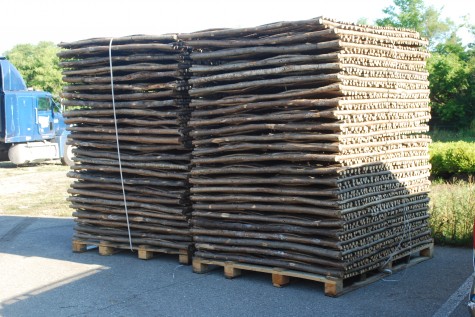
 The woven branches have a great texture, and cast good shadows. The surface is lively and warm. Burt told Rob he sold Italian shoes for 25 years, before opening his twig panel business. It is easy for me to see why he would do this; it must give him great satisfaction to be making objects that celebrate the beauty of the natural world. Rhododendron root furniture, log furniture, twig trellissing-all of these things have a primeval appeal.
The woven branches have a great texture, and cast good shadows. The surface is lively and warm. Burt told Rob he sold Italian shoes for 25 years, before opening his twig panel business. It is easy for me to see why he would do this; it must give him great satisfaction to be making objects that celebrate the beauty of the natural world. Rhododendron root furniture, log furniture, twig trellissing-all of these things have a primeval appeal.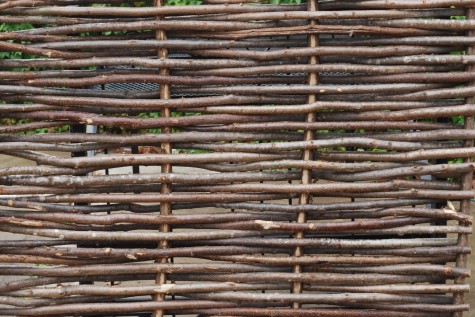
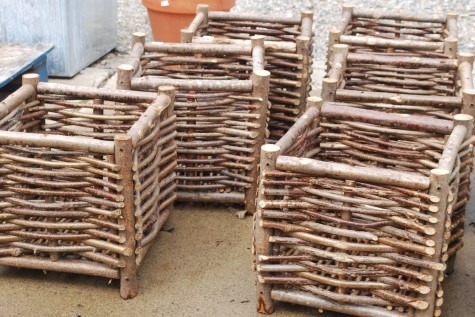
 Positioned with the twigs in the vertical, the panels have a different quality about them-more sculptural and sinuous. I had a client tell me she loves the beauty of ordinary materials. Things people make of ordinary materials can be anything but ordinary. A material like this is just waiting for an inspired placement.
Positioned with the twigs in the vertical, the panels have a different quality about them-more sculptural and sinuous. I had a client tell me she loves the beauty of ordinary materials. Things people make of ordinary materials can be anything but ordinary. A material like this is just waiting for an inspired placement. 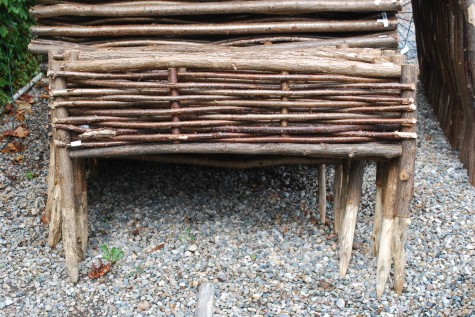
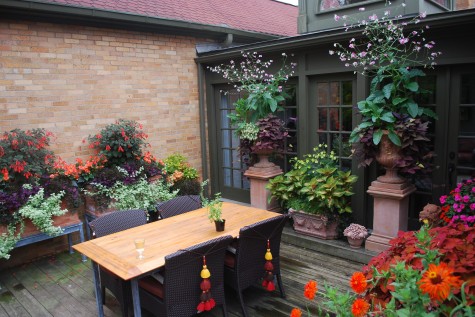
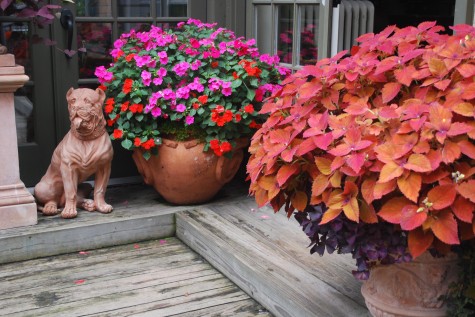 I like the fireworks going-on feeling of my terrace pots this year. Most of that has to do with how they have grown. I picked the colors and plants yes, but nature has proved unusually cooperative. We have had cool temperatures all summer, and now, regular rain. The usual bugs and disease must be at someone else’s house.
I like the fireworks going-on feeling of my terrace pots this year. Most of that has to do with how they have grown. I picked the colors and plants yes, but nature has proved unusually cooperative. We have had cool temperatures all summer, and now, regular rain. The usual bugs and disease must be at someone else’s house.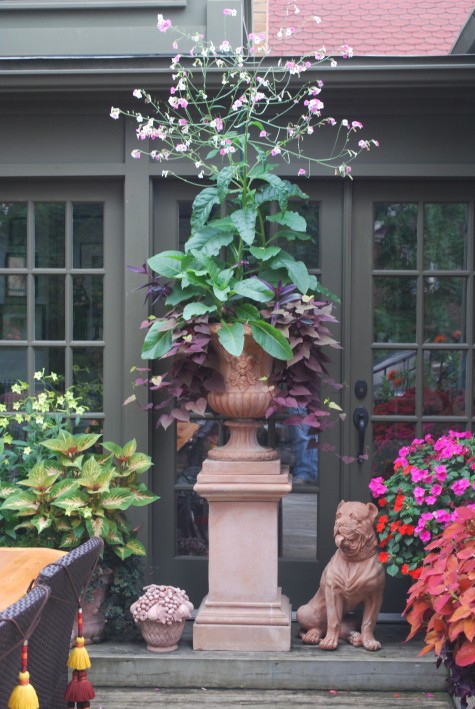 The Mital terra cotta gargoyle pots on their pedestals have never looked so rowdy and profuse. I grow nicotiana mutabilis every year for exactly the reason you see here. The showy oregano in this pot gave up and died, but I hardly notice. Besides, this pair of pots started out mismatched-I like that they will end up mismatched.
The Mital terra cotta gargoyle pots on their pedestals have never looked so rowdy and profuse. I grow nicotiana mutabilis every year for exactly the reason you see here. The showy oregano in this pot gave up and died, but I hardly notice. Besides, this pair of pots started out mismatched-I like that they will end up mismatched.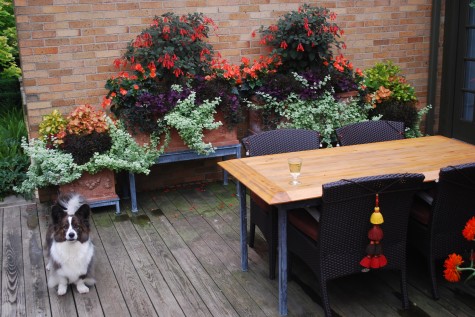
 These two licorice plants have made a flared skirt of themselves. The shape is especially attractive with the garland pattern on the pot. Did I plan this part-absolutely not. Anyone who gardens gets to enjoy the unexpected.
These two licorice plants have made a flared skirt of themselves. The shape is especially attractive with the garland pattern on the pot. Did I plan this part-absolutely not. Anyone who gardens gets to enjoy the unexpected.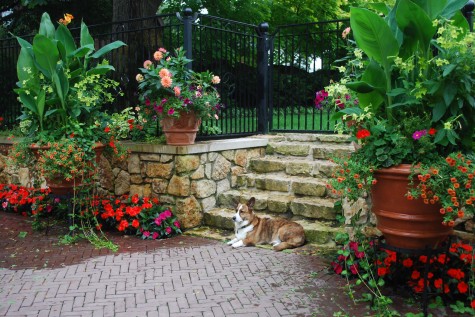 The New Guinea impatiens this year are unbelievably gaudy-what fun. Even my million bells, which usually sulk as I have very alkaline water, are cooperating. My dahlias do not have mites or mildew. The cool weather has slowed the flower production on the cannas, but the foliage alone is well worth having.
The New Guinea impatiens this year are unbelievably gaudy-what fun. Even my million bells, which usually sulk as I have very alkaline water, are cooperating. My dahlias do not have mites or mildew. The cool weather has slowed the flower production on the cannas, but the foliage alone is well worth having.
